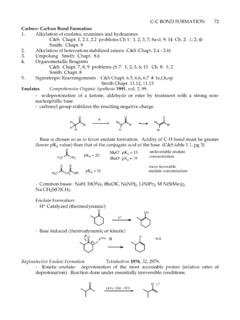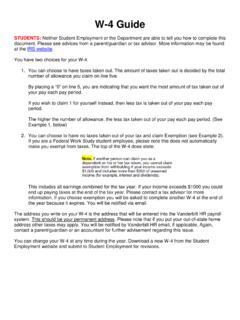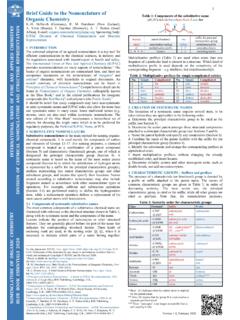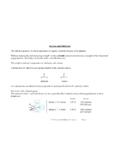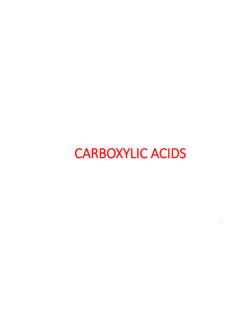Transcription of Chapter 6. Alkenes: Structure and Stability
1 1 Chapter 6. alkenes : Structure and StabilityDegrees of unsaturationsaturated hydrocarbonCnH2n+2cycloalkane (1 ring)CnH2nalkene (1 p-bond)CnH2nalkyne (2 p-bonds)CnH2n-2 For each ring or p-bond, -2H from the formula of the saturated alkaneDegrees of unsaturation: # of rings and/or p-bonds in a molecule. Information can be obtained from the molecular formulaOHOS teric Acid (saturated fatty acid)OHOL inoleic Acid (unsaturated fatty acid)Correction for other elements:For Group VII elements (halogens): subtract 1H from the H-deficiency for each halogen, or add 1H to the molecular formula of each halogenFor Group VI elements (O and S)No correction is neededFor Group V elements (N and P)add 1H to the H-deficiency for each N or Por subtract 1H from the molecular formula for each N or P NNCH3 HOClC6H6C10H14N2C11H11 OCl2 Naming AlkenesSuffix: -eneMany of the same rules for alkanes apply to the parent hydrocarbon by locating the longest carbon chain that contains the double bond and name it according to the number of carbons with the suffix = pentenenot hexene (does not contain double bond)Systematic nomenclature (IUPAC System)Prefix-Parent-Suffix2a.
2 Number the carbons of the parent chain so the double bond carbons have the lowest possible numbers. b. If the double bond is equidistant from each end, number so the first substituent has the lowest out the full name, numbering the substituents according to their position in the chain and list them in alphabetical the double bond by the number of the first alkene more than one double bond is present, indicate their position by using the number of the first carbon of each double bond and use the suffix -diene (for 2 double bonds), -triene (for 3 double bonds), -tetraene (for 4 double bonds), ,4-pentadieneH2 CCHCHCHCH3123451,3-pentadieneCH31233-met hylcyclohexeneCH3123456 NOT6-methylcyclohexene6a. Cycloalkenes are named in a similar way. Number the cycloalkene so the double bond carbons get numbers 1 and 2, and the first substituent is the lowest possible there is a substituent on one of the double bond carbons, it gets number ,5-dimethylcyclopenteneNOT2,3-dimethylcy clopentene4 alkenes as substituents:CHCH2ethenyl or vinyl(vinylcyclohexane)CH2 CHCH22-propenyl or allyl(allylcyclohexane)CH2methylene(meth ylenecyclohexane)HCCH3ethylidene(ethylid enecyclohexane)Non-IUPAC alkenes (Table , pg.)
3 194)H2 CCH2 CHCH2H3 Cethylene(ethene)propylene(propene)CCH2H 3CH3 Cisobutylene(2-methylpropene)CCHH2 CCH3CH2isoprene(2-methyl-1,3-butadiene)S qualene (C30, 6 isoprene units)b-carotene (C40, 8 isoprene units)Isoprene (C5)HOCholesterol (C27H46O)5 3 CH3CO2H+ CO2 + 2 H2 OHO2 CCO2 HOHH3 CHMG-CoA ReductaseHO2 COHH3 COHmelvolonic acidsqualenecholesterolOHCO2 HHOH3 CCH3 OOCH3 LovastatinHC=C double bonds6+235 KJ/mol-235 KJ/molpp*+376 KJ/mol-376 KJ/molss*sp2sp2ppMolecular Orbitals of a Carbon-Carbon Double BondAlkenes Stereoisomersrecall cycloalkane stereoisomers: substituents are either on the sameside of the ring (cis) or on opposite sides (trans).Substituents on an alkene can also be either cis (on the same side ofthe double bond) or trans (on opposite sides of the double bond. Cis/trans isomers of alkenes are stereoisomers- they have the sameconnectivity but different three-dimensional arrangements of groups7 Designating Alkene StereoisomersThe cis and trans becomes ambiguous when there are three or four substituents on the double bond.
4 E/Z System: For each carbon of the double bond, the groups are assigna priority (high or low) according to a system of rules. Thus, the highpriority groups can be on the same side or on opposite the high priority groups are on opposite sides then the double bond is designated as E (entgegen- across) If the high priority groups are on the same side then the double bond is designated as Z (zusammen- together)EZAssigning Group Priority: The Cahn, Ingold, Prelog at the atoms directly attached to each carbon of the double bond. Rank them according to decreasing atomic number. priority of common atoms: I > Br > Cl > S > F > O > N > C > H If both high priority atoms are on the same side of the double bond it is designated Z. If the high priority atoms are on opposite sides of the double bond, it is designated as (E)-2-chloro-2-butene(Z) If the two atoms attached to the double bond carbon are identical (designated A and B below), look at all the atoms directly attached to the identical atoms in questions (designated A-1, A-2, A-3 and B-1, B-2, B-3).
5 Assign priorities to all these atoms based on atomic number (1 is the highest priority, 3 the lowest). A-1B-1A-2 ABB-2A-3B-3 XGroup AGroup B2b. Compare the highest priority atoms, compare A-1 with B-1. If A-1 is a higher priority atoms than B-1, then A is higher priority than B. If A-1 and B-1 are the same atom, then compare the second highest priority atoms directly bonded to A and B (A-2 with B-2); if A-2 is a higher priority atom than B-2, then A is higher priority than B. If A-2 and B-2 are identical atoms, compare A-3 with B-3. c. If a difference still can not be found, move out to the next highest priority group (A-1 and B-1 in the diagram) and repeat the (Z)-3-methyl-2-pentenehighpriorityhighpr iorityCCH3CH3CH3 CHCH3CH3>CH2CH3>CH3>H>CH2Cl>CHCH3CH3 OCH3> bonds are considered equivalent to the same number of single bonded Stability :H3 CCH3 HHH3 CHHCH3cis-2-butenetrans-2-buteneH+Cataly stat equilibrium, the ratio is 76% trans and 24% cis.
6 DG = KJ/molH3 CCH3 HHH3 CHHCH3cis-2-butenetrans-2-buteneDH combustion : KJ/mol KJ/mol less energy is given off from trans isomer H3 CCH3 HHH3 CHHCH3cis-2-butenetrans-2-buteneH2, PdH2, PdCH3CH2CH2CH3DH hydrogenation: -120 KJ/mol -115 KJ/mol5 KJ/mol less energy is given off for trans isomer 10H3 CCH3 HHH3 CHHCH3CH3CH2CH2CH3 The greater release of heat, the less stable the (pg 204). Heats of Hydrogenation of Some Alkenesmeasure of alkene (KJ/mol)RRHHRHHRRHHHRHRHRRRHRRRR>>>>_~te trasubstituted > trisubstituted > disubstitutued > monosubstitutedTrend: increased substitution decreases DH hydrogenation. Increasedsubstitution increases the alkene Stability . More substituted alkenes are favored over less substituted alkenesHyperconjugation: stabilizing effect due to bonding interactionsbetween a filled C-H orbital and a vacant neighboring orbitalIncreasing the substitutionof an alkene, increases the number of possiblehyperconjugationinteractions12 Electrophilic Addition of HX to AlkenesREAD: Writing Organic Reactions (pg 208)DG < 0DG for step one is large (slow)DG for step twois small (fast)CCH2H3CH3 CHXCCH3H3CH3CX+CCH2XH3CH3 CHnone of thisetherMarkovnikov s Rule.
7 For the electrophilic addition of HX across aC=C bond, the H (of HX) will add to the carbon of the double bond with the most H s (the least substitutent carbon) and the X will addto the carbon of the double bond that has the most alkyl s rule can be explained by the comparingthe Stability of the intermediate carbocationsCCH2H3CH3 CHClCCH3H3CH3 CCl+CCH2 ClH3CH3 CHnone of thisetherHBr+etherBrCH3CH3 Brnone of thisHBrether+BrBrboth products observed13 Carbocation Structure and StabilityCarbocations are sp2 Hybridized and have a trigonal planar geometryHyperconjugation stabilizes carbocations. Thus, more substituted carbocations are more stable. vacant p-orbitalThe C-H s-bond on the neighboring carbon lines up with the vacant p-orbital and can donate electron density to the carbon cation. This is a bonding interaction and is stabilizing. The more hyperconjugationthat are possible, the more stable the carbocation14 Inductive Effects (section ): shifting of electrons in a s-bond inresponse to the electronegativity of a nearby atom (or group).
8 Carbon is a good electron donor. Substitution can also stabilizecarbocations by donating electron density through the s-bond. 3 : three alkyl groupsdonating electrons2 : two alkyl groupsdonating electrons1 : one alkyl groupdonating electronsHHCH+HHCR+RHCR+RRCR+Methyl: no alkyl groupsdonating electronsFor the electrophilic addition of HX to an unsymmetricallysubstituted alkene: The more highly substituted carbocation intermediate is formed. More highly substituted carbocations are more stable than less substituted carbocations. (hyperconjugation) The more highly substituted carbocation is formed faster than the less substituted carbocation. Once formed, the more highly substituted carbocation goes on to the final product more rapidly as well. 15 The rate of a reaction is dependent upon DG There is no formal relationship between DG and DG What is the Structure of a transition state?
9 How can the structures of the reactants and products affect DG Hammond Postulate: provides an intuitive relationship between rate (DG ) and product Stability (DG ).The Hammond Postulate: The Structure of the transition state more closely resembles the nearest stable species ( , the reactant, intermediate or product) DG = 0DG > 0DG < 0TS is halfway betweenreactant and products onthe reaction coordinateTS lies closer to the products than thereactants on the reaction coordinateTS lies closer to the reactants than theproducts on the reaction coordinate16 The Hammond Postulate: The Structure of the transition state more closely resembles the nearest stable species ( , the reactant, intermediate or product).For an endergonic reaction (DG > 0), the TS is nearer to the products. The Structure of the TS resembles that of the products. Therefore, things that stabilize the product will also stabilize the TS leading to those an exergonic reaction (DG < 0), the TS is nearer to the reactants.
10 The Structure of the TS resembles that of the reactants. For the electrophilic addition of HX to Alkenes: 17 Carbocation Rearrangments: In reactions involving carbocation intermediates, the carbocation may sometimes rearrange if a more stable carbocation can be formed by the rearrangement. These involvehydride and methyl shifts. CCCH3CH3 CHHHHH-ClCCCH3CH3 CHHHHClH+CCCH3CH3 CClHHHHH~ 50%~ 50%expected productCCCH3CH3 CCH3 HHHH-ClCCCH3CH3 CCH3 HHHClH+CCCH3CH3 CClHHHH3 CHNote that the shifting atom or group moves with its electron pair. A MORE STABLE CARBOCATION IS -OO -OO -OHAHOHOF arnesyl pyrophosphate (C15)Squalene Oxide (C30H50O)2 Squalene synthetaseSqualene (C30H50)+Squalene epoxidase+SqualenecyclaseProtosterol (C30H50O)HO+HO+HO+HCH3H3 CHOCH3CH3CH3 HHHHS teroid Biosynthesis: Polyene Cyclizations18 HAHOHOC holesterol (C27H46O)Lanosterol (C30H50O)Protosterol (C30H50O)CH3H3 CHOCH3CH3CH3 HHHHCH3H3 CHOCH3CH3CH3 HHHH+CH3H3 CHOCH3 HCH3CH3 HLanosterol (C30H50O)Oxidative Stress- a free radical chain processCellular respirationO2 _+ Fe (III)HO + HO _ + Fe(III)Fe (II) + O2Fe (II) + H2O2O2 _+ NOONO2 _nitricoxideperoxynitrateH+ONO2 HperoxynitrousacidNO2 + HO Reactive OxygenSpecies (ROS)O24 e ,4H+2 H2O _O2 _Superoxide.


